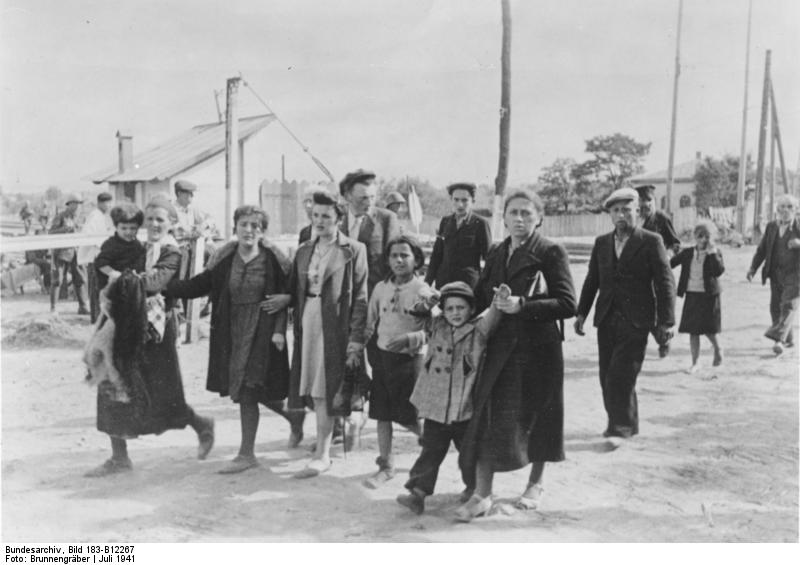
In Chisinau, there is a monument to victims of the Holocaust at the corner of Jerusalem Street and a Grigore Vieru Boulevard, just steps away from the city’s main square. But most people walk by without paying attention.
A few years ago, Radio Free Europe/Radio Liberty stopped passersby to ask if they knew the significance of the monument. Here’s how that went:
Moldova hasn’t done a good job of discussing the Holocaust. In fact, history textbooks skipped it altogether until about 2005, according to historians. After that, it was discussed briefly and without mention of Romania’s role in the murder of hundreds of thousands of Jews and Roma. Part of the reason Moldova has been so reluctant to talk about the Holocaust is the fact that Romanian soldiers, often with the help of the local population, were just as responsible for the mass murders as the Nazis. In a country where much of the population identifies as ethnically Romanian — where some still consider Romania’s World War II-era dictator a hero — this is uncomfortable history. How much of the historical amnesia can be attributed to pro-Romania sentiment and how much to the Soviet Union’s downplaying of the Holocaust in general? Hard to say.
When Germany invaded the Soviet Union on June 22, 1941, Moldova (then known as Bessarabia), had recently been occupied by the Soviet Union as part of the Molotov-Ribbentrop pact between Hitler and Stalin. Now German troops and their Romanian allies occupied it once more, marching in along with Einsatzgruppe D (Nazi units whose main objective was the destruction of Jews). Here is an excerpt from a 2004 report about what happened next.
“In the summer and fall of 1941, on the roads and in the fields of Bessarabia, Jews walked in rows, accompanied by gendarmes and followed by peasants, who were mobilized by gendarmes, clerks, and village mayors, carrying shovels and spades, all going to the execution fields. They waited patiently until the gendarmes had shot the Jews, then buried them and returned home with the victims’ clothes and other personal effects; the valuables and money were taken by the gendarmes. Quite often the gendarmes would get drunk and revel all night after such a day’s work. In the village of Grigoriefca, in Lapusna County, they so indulged after murdering 60 Jewish men and before liquidating another 140 the next day; a few gendarmes remained in the killing field ‘to guard the corpses.'”
Historians estimate that 100,000 to 200,000 Jews were deported to labor camps in nearby Transnistria, where most would die. Pecioara (or Pechora, a village in present-day Ukraine) was the worst destination of all:
“The other Transnistrian camp, Peciora, displayed the phrase ‘death camp’ on its signpost above the entrance. General Iliescu, inspector of the Transnistrian gendarmerie, had recommended that the poorest be sent there, since they were going to die anyway, and it was not intended that anyone survive Peciora.”
In Chisinau, Jews were ordered to leave their homes and move into a ghetto, the first stop on a journey that ended in Transnistrian labor camps. This is a photo from the German Federal Archives, taken in July 1941:

In the last few years, Moldova has been taking steps in the right direction and bringing some of this history to light. There is a long way to go but it’s not too late. Stories are still out there to be gathered.
Moldova, new to Holocaust remembrance, institutes a plan https://t.co/kKfL4QAoNw via @Jerusalem_Post
— Nino Brodin (@Catuvolcus) February 2, 2019
@ItalyatOSCE Special Rep Rabbi Baker in Vienna today learned from Amb. Osipov about positive news from #Moldova concerning official decision to open Jewish museum in #Chisinau. Important step for Holocaust rememberance and fighting antisemitism. pic.twitter.com/X3Qmou6HsM
— Siegfried Wöber (@SWoeber) October 18, 2018
In #Moldova, our team interviewed Pavel, who participated the in the arrest of Jews along with the Romanian gendarmes. He was told to keep guard while the Romanians arrested Jews in their homes.#Holocaust #Shoah #Witness #WW2 pic.twitter.com/RWyhxaVmSY
— Yahad – In Unum (@yahadinunum) April 19, 2019
Recent Comments